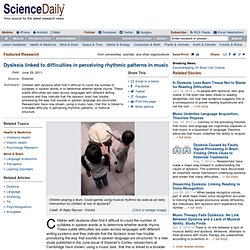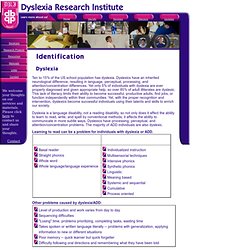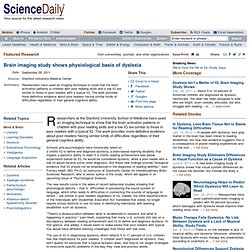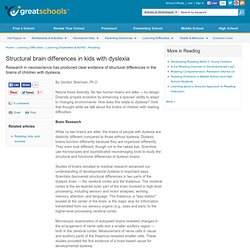

Dyslexia linked to difficulties in perceiving rhythmic patterns in music. Children with dyslexia often find it difficult to count the number of syllables in spoken words or to determine whether words rhyme.

These subtle difficulties are seen across languages with different writing systems and they indicate that the dyslexic brain has trouble processing the way that sounds in spoken language are structured. In a new study published in the June issue of Elsevier's Cortex, researchers at Cambridge have shown, using a music task, that this is linked to a broader difficulty in perceiving rhythmic patterns, or metrical structure.
Martina Huss, Usha Goswami and colleagues gave a group of 10-year-old children, with and without dyslexia, a listening task involving short tunes that had simple metrical structures with accents on certain notes. The children had to decide whether a pair of tunes sounded similar or different. To make two tunes sound "different," the researchers varied the length of the stronger notes. Dyslexia Research Institute. In order to have a proper diagnosis and proper plan of intervention and remediation, a thorough differential diagnosis should be administered, which considers the entire syndrome of dyslexia and attention deficit disorders.

No SINGLE test exists that can identify dyslexia. No IQ test exists that can identify dyslexia. Diagnosticians should give a variety of tests which examine the individual's learning, language, perceptual, and intellectual strengths and weaknesses. Diagnosticians may be educational specialists, speech and language pathologists, or psychologists who are trained in the field of dyslexia. Questions PARENTS should ask when choosing a diagnostician: 1.
Concerning dyslexia have you been affiliated with? 2. Model, which is used by the public schools? Appropriate.) 3. Music therapy fails dyslexics: No link between dyslexia and a lack of musical ability, study finds. There is no link between a lack of musical ability and dyslexia.

Moreover, attempts to treat dyslexia with music therapy are unwarranted, according to scientists in Belgium writing in the current issue of the International Journal of Arts and Technology. Cognitive neuroscientist José Morais of the Free University of Brussels and colleagues point out that research into dyslexia has pointed to a problem with how the brain processes sounds and how dyslexic readers manipulate the sounds from which words are composed, the phonemes, consciously and intentionally. It was a relatively short step between the notion that dyslexia is an issue of phonological processing and how this might also be associated with poor musical skills -- amusia -- that has led to approaches to treating the condition using therapy to improve a dyslexic reader's musical skills.
Language and music are apparently uniquely human traits and many researchers have tried to find direct links between the two. 7943.full. Brain Basis for Dyslexia. A Summary of Work in Progress D.

Lynn Flowers Abstract Studies of brain/behavior relations in the last decade have converged to suggest a left-hemisphere functional deficit for dyslexia. The relationship is most convincing at the microscopic level, where anomalous neural organization has been associated with reading, and at the macroscopic level, where several studies find atypical hemispheric symmetry in the language-related temporal region in individuals with dyslexia. Brain imaging study shows physiological basis of dyslexia. Researchers at the Stanford University School of Medicine have used an imaging technique to show that the brain activation patterns in children with poor reading skills and a low IQ are similar to those in poor readers with a typical IQ.

The work provides more definitive evidence about poor readers having similar kinds of difficulties regardless of their general cognitive ability. Dyslexia Explained. What is Dyslexia?

Dyslexia is a specific disassociation in the functioning system of individuals whose overall motor, language, cognitive, and social/emotional development are in the normal range for their age; It is where a person's component processing skills (functional system) level and the pattern of uneven development (disassociation) display more than the two skills at unrelated rates which would signify them displaying dyslexic tendencies (Dyslexia Success, 2012). Telephone: 01234 219193 Email: dyslexiasuccess@aol.com Dyseidetic (visual) Dyslexia. A person with Dyseidetic Dyslexia, does not usually experience difficulty in understanding phonics, however, will have problems in reading and/or spelling words. Meares/Irlin syndrome also known as Scotopic Sensitivity is prevalent when black print on a white background is recognised as a major barrier to a person's ability to read.
Is Dyslexia and intelligence related? Explained by Dr. Poysky from Texas ENT. Structural brain differences in kids with dyslexia - Reading. By Gordon Sherman, Ph.D.

Nature loves diversity. No two human brains are alike — by design. Diversity propels evolution by enhancing a species' ability to adapt to changing environments. How does this relate to dyslexia? Hold that thought while we talk about the brains of children with reading difficulties. Brain Research While no two brains are alike, the brains of people with dyslexia are distinctly different compared to those without dyslexia. Studies of brains donated to medical research advanced our understanding of developmental dyslexia in important ways. Microscopic examination of autopsied brains revealed changes in the arrangement of nerve cells and a smaller auditory region — both in the cerebral cortex. Differences in the Cerebral Cortex Let's look more closely at the changes in the cortex. These ectopias are caused by a change during neuronal migration — the journey all newborn neurons undergo to their final positions in the brain.